Strengthening the Grid With Transmission
America’s electric grid, originally built in the early 20th century, powered the United States’ rise as an economic powerhouse. Today, however, 70% of our power lines are over 30 years old, and the way power is generated and where energy resources are located have evolved. Aging infrastructure, increasing energy demand, the critical need for energy security, and more frequent weather-related power disruptions demand immediate action to strengthen and modernize our grid.
Grid United develops long-distance transmission lines that bolster America’s energy security, enhance grid reliability, and ensure our power grid is resilient enough to support economic growth and meet the nation’s energy needs well into the future.
Grid United is advancing transmission projects in strategic locations.

THE ADVANTAGES OF TRANSMISSION
Reliability
Efficiency
Recent reports describe the benefits of transmission buildout.
Understanding Direct Current Technology
The Advantages of DC
More
Efficient
Lower
Cost
Improved
Reliability
Smaller
Footprint
Currently there are more than 20 DC transmission facilities in the United States and more than 35 DC transmission facilities across the North American grid, as indicated in the map below.


